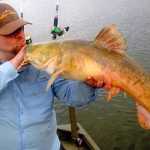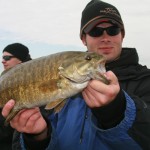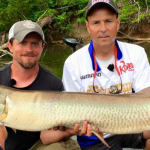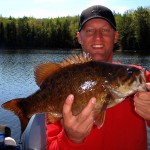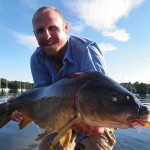By: Jim Gronaw – Date Posted: January 20, 2011
They’re big, they’re bad, and now they exceed a hundred pounds. No, I’m not talking about cobia, black drum or even the ever-popular striped bass. I’m talking about blue catfish; a non-native transplant that was stocked in selected tidal river systems more than 30 years ago by the Virginia Department of Game and Inland Fisheries. In particular, the tidal James River and its’ adjoining tributaries. Yes, catfishing is coming of age nowayears and as more and more big fish show up, regional anglers are starting to pay attention to this world class fishery that is right under the nose of millions of ‘back east’ anglers in the Mid-Atlantic.
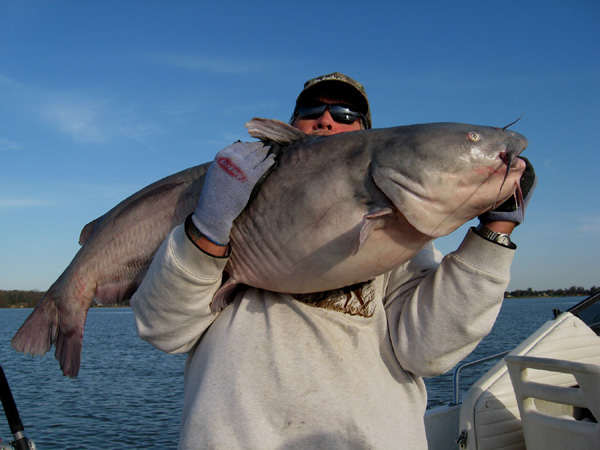
I had the chance to fish with catfishing legend Chris Eberwein on the James along with my son Matt in quest of these big cats. Eberwein has a guarantee for his clients…no citation blue cats ( 30 pounds and up ) then no pay. Pretty good deal, if you ask me. Our first mate for the day was Dustin Eberwein, Chris’s 23 year-old son and a seasoned catfish angler in his own right. Launching out of the Jordan Point Marina a few miles downstream from Hopewell, Virginia, the Eberweins wasted no time in catching gizzard shad with the cast net and the gillnet to use for bait on the big blues.
With bait in the box, they went about a mile upriver and set up just upcurrent from a series of underwater humps in about 25 feet of water. It took probably less than two minutes to anchor up on the hole and quickly their heavy baitcast outfits were heaved out with hunks of cut shad. After about ten minutes and a few tentative strikes, I asked Chris how long do they usually stay on a hole. ‘We’re getting’ ready to leave now’ was the quick response. Dustin yanked the anchor as Chris idled up the Suzuki engine on his Carolina Skiff and we were off to the next catfish hole. This would be repeated at least a dozen more times throughout the day, being prolonged only by the hooking, landing and photo taking of fish.
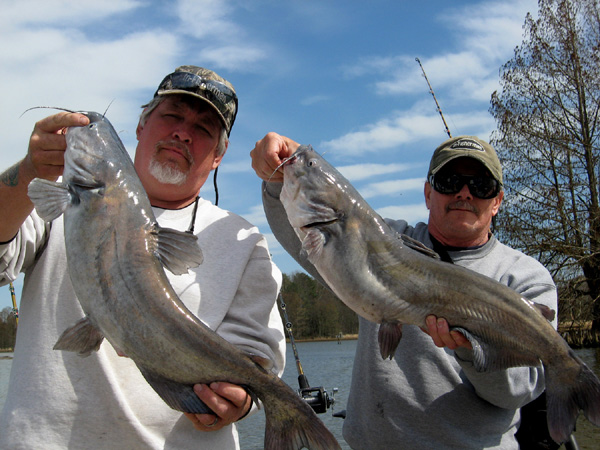
RUN AND GUN CATFISHING…
The old concept of catfishing on a deep hole on a river and waiting the fish out is not what gets the cats for top area guides like Eberwein. In contrast to old school tactics of waiting on active fish to come to you, it is far better to be mobile and actively seek bluecats from one spot to the other. As tides change by the hour, certain spots will draw big blues and you have to ‘run and gun ‘em’ as Eberwein says, to stay on top of an active bite. Tidal cats are different from those that are in ‘one way’ flowing rivers, as they have to adapt to the reversing of the tides every six hours. And then again, some spots only produce at a particular stage of an incoming or an outgoing tide. Some holes produce best at low tide, others do well at high tide.
I asked Chris how many spots did he have to fish for these blues on the James. He told me that he had currently waypointed 619 spots on the river on his GPS. But he admitted that he only recorded spots that had ‘produced 50 pound or betta’ blue cats’ over the years. Sheesh, I don’t think I have fished 619 places in my entire life, for all species, let alone just one specie in one river system. Wow!
Soon, we pulled up on a ‘spot’ that was just a slight dip in the river bottom in about 20 feet of water. Eberwein pointed out that there was a fair concentration of brush and wood debris that had washed into this area and it was a drawing card for cats. Before we could get all the rods out, one of them was down to the waters edge and my son Matt jumped on it and started a steady ‘lift-and-reel’ tug of war back to the boat. Soon, the first Virginia citation blue cat, a chubby 35 pounder, was netted and flopping in the bottom of the boat. After a brief photo session and a quick release, another rod went down and I grabbed that one, which resulted in a nice 25 pounder.
It should be pointed out that the current Virginia citation minimum for blue cats is 30 pounds. That benchmark is easily achieved during prime winter months, often several times a day, on the James. In the winter of February 2010 Eberwein told me he had a string of twenty days where he had ‘at least one 70-pouda’ every day. Top area guides actually prefer November through early March as the best times for upper end fish. And in truth, most serious catfishermen on the river don’t get too excited unless a 50 pounder, or better, hits the deck. After another thirty-plus cat and a couple of teenagers, the boys decided to pull anchor and look for bigger fish.
We hit a few more areas of sunken brush and logs and I was surprised as to how structure – oriented these fish were. Often thought of as strictly fish of the deep, tidal blues are very much attracted to wood cover in the form of fallen, deep trees, washed-in logs and debris or submerged barges or old pier pilings. In our two-day run on the James, we caught some of our best fish in relatively shallow areas that would draw run-and-gun bass anglers.
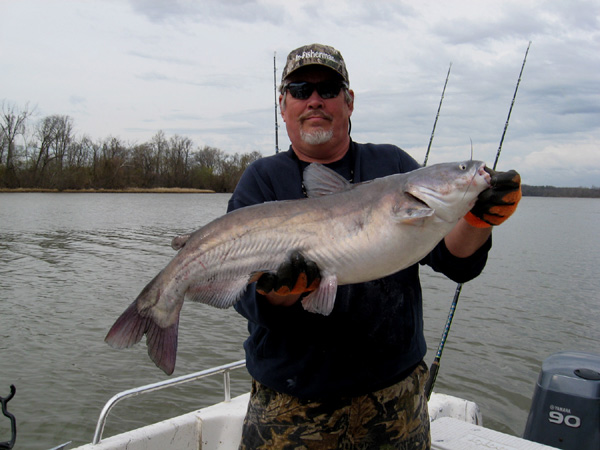
ROCKS AND DEPRESSIONS…AND MORE…
As good as wood can be, Eberwein also likes to fish submerged rock piles. We pulled up on just such a spot and set up quickly and picked up a low thirty and an upper twenty. After a few light strikers, one of the rods took a serious bend and I wrestled it from the rod holder. Initially, the fish came toward the boat, but once it realized it was hooked it made plans for escape. With an incoming tide running at a good clip, the fish was dramatically stronger than any of the others we had fought. Despite the heavy gear and 100 pound test leader, I took my time with this fish that just didn’t want to come up. Cautiously, I would gain line, almost see the fish, then lose line as it took of on a powerful, surging run. After nearly 15 minutes of give and take, I worked the big cat boat -side and Eberwein put the net under a barrel-chested blue that pulled the scales to 58 pounds. An easy personal best for me, I couldn’t wait to bear hug the beast for photos.
We ended up with ten cats our first day on the river…not bad when you consider that most folks consider catfishing a summer time gig. We fished with Capt. Joe Hecht on our second day. He took us to portions of the James that were close to the city limits of Richmond. By fishing small wing dams and the eddys behind them, we managed 13 blues. Matt and I had one very hectic and exciting double were I got a 44 and he wrestled a 53 pounder, his personal best, on the same side of the boat and literally seconds apart. There are few places where a freshwater angler can fish with a reasonable certainty of landing several fish in any given day that will run from 30 to 50 pounds. The James River blue cat gig is one of those places.

Back in March of 2010, my friend Charlie Wallace and I did the blue cat boogie with Hecht and Eberwein and found not huge, but quality fish, in as shallow as two feet of water as 15 to 20 pounders would move up into sun-warmed backwaters when high tide rolled in. At times Hecht admitted that’decent’ fish, to 40 pounds, could be had in such conditions and it was a lot of fun ‘if you didn’t mind small fish’. Yeah… I think I could put up with that!
On that trip, Charlie got the big-fish honors with powerhouse 60-pounder that struck in the last few minutes of the trip. Like most big fish do, the rod just pegged over and screamed and Charlie wrestled the rod out of the holder. Even with heavy gear, big blues can challenge both tackle and fish playing skills of any angler. Charlie kept the pressure on the fish and it literally looked like a small cow coming to the net. After many long, tense minutes, the barrel-chested fish was thumping the deck of Capt. Joes’ Carolina Skiff.

It should be pointed out that the blue cat fishery on the James is an almost total catch-and-release gig, due in part to fish consumption advisories that are placed on a variety of species. Many locals eat some of the smaller cats, under ten pounds. Also this is an outstanding waterway for resident largemouth bass, slab crappie, migratory shad, perch and striped bass and top-notch smallmouth bass fishing upstream from Richmond.
BIG CAT GEAR…
Tackle considerations are somewhat standard across the board for James River cat guides and serious catfishermen in the region. Ambassadeur 7000 baitcasters with 30 to 80 pound mono as the mainline and leader material ranges from 50 to 100 pound mono are popular, as are Okuma and Penn reels that are comparable. Fish finder rigs with 6 to 10 ounces of weight hold the cut shad near the bottom as most use one to two foot leaders with 8/0 or 10/0 Owner or Gamakatzu circle hooks. Portions of cut gizzard shad, steaked or filleted, are hooked with much of the hook point exposed.
Rod selection can be a matter of choice. Fiberglass rods of 7 to 7 ½ feet are popular. Heavy or medium heavy Ugly Sticks or Tiger Series rods do well, but the locals all have their favorites. If you have gear for cobia, drum or big stripers then you can likely adapt without too much additional purchase. The standard sinker size for the fish-finder rig is 6 or 10 ounces.
As pointed out earlier, Eberwein likes to fish wood, and sometimes that means losing rigs and even losing fish. But it is where they are. He uses 80 pound Trilene Big Game for a mainline and cranks the drag down pretty tight. When a fish pulls drag on one of his rigs, you know you’ve got one of the ‘boys’. By comparison, Capt. Joe Hecht, another top area catfish guide, uses 30 to 40 pound mainline and likes Quantum BigCat rods to do the dirty work. Capt. Hecht specializes in hauling big blues and flatheads out of wingdams and logjams further upriver as the James approaches the Richmond city limits.
If you’re looking for some exciting, trophy catfishing you might want to consider a trip this winter to the James. The current Virginia record came from the James and went 102 pounds and 4 ounces. Many hundreds of 50 pound plus blues are taken annually, and the winter months see the bulk of those trophies. They are big, bad and in their own way, beautiful!

HIRE A GUIDE…
The tidal James is a vast waterway with shallow flats, large embayments, winding channels and large open areas that can quickly turn to whitecaps when approaching cold fronts put 15 to 20 mph winds on the river. Regardless of your boating skill or catfish savvy, you will learn more in one day from an experienced area guide than in a dozen trips on your own. Do the smart thing and contact one of these USCG licensed guides and let them put you on the catfish of a lifetime. These guys can put you on a big-fish trip of a lifetime.
EBERWEINS’ CATFISHIN’-Capt. Chris Eberwein, 804-449-6134, www.catfishingva.com
FAT CAT GUIDE SERVICE- Capt. Joe Hecht, 804-221-1951, www.fatcatguide.com
By: Jim Gronaw
Date Posted: January 20, 2011



